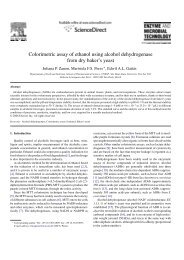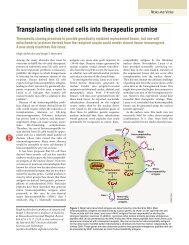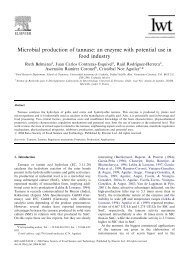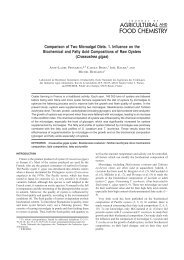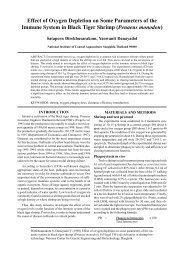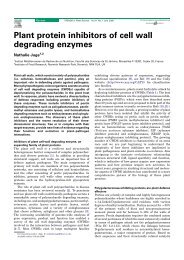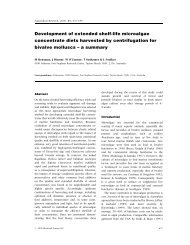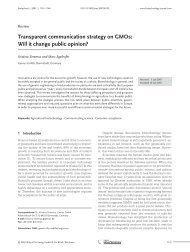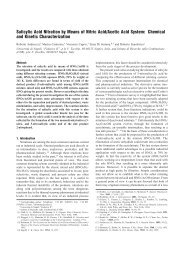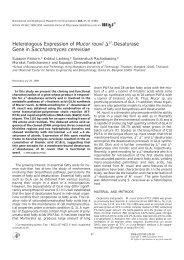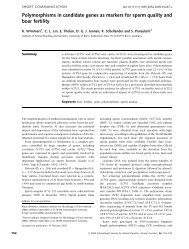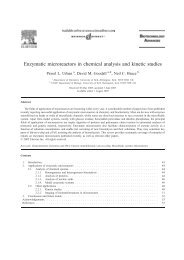Comparison of RAPDs, AFLPs and SSR markers for the genetic ...
Comparison of RAPDs, AFLPs and SSR markers for the genetic ...
Comparison of RAPDs, AFLPs and SSR markers for the genetic ...
Create successful ePaper yourself
Turn your PDF publications into a flip-book with our unique Google optimized e-Paper software.
Biosystems,Foster City,Cali<strong>for</strong>nia,USA). PCR1<br />
reaction mix contained 5 pmol <strong>of</strong> ScAAT2 primer pair<br />
fluorescent-dye labeled with HEX (yellow),5 pmol <strong>of</strong><br />
ScAAT3 primer pair fluorescent-dye labeled with 6-<br />
FAM (blue),7.5 pmol <strong>of</strong> ScAAT5 primer pair fluorescent-dye<br />
labeled with TET (green),<strong>and</strong> 1 U <strong>of</strong> Taq<br />
DNA polymerase (Biotools,Biotechnological <strong>and</strong> Medical<br />
Laboratories,S.A.,Madrid,Spain) in 1 reaction<br />
buffer (75 mM Tris HCl pH 9.0,50 mM KCl,20 mM<br />
(NH4)2SO4). PCR2 reaction mix contained 2.5 pmol <strong>of</strong><br />
ScAAT4 primer pair fluorescent-dye labeled with TET,<br />
2.5 pmol <strong>of</strong> ScAAT6 primer pair fluorescent-dye labeled<br />
with HEX,10 pmol <strong>of</strong> ScAAT1 primer pair fluorescentdye<br />
labeled with 6-FAM,<strong>and</strong> 1.5 U <strong>of</strong> Taq DNA<br />
polymerase.<br />
The amplification reactions were carried out using a<br />
DNA Thermal Cycler 9600 (Applied Biosystems) under<br />
<strong>the</strong> following conditions: a preliminary step <strong>of</strong> 5 min at<br />
94 1C; 10 cycles each <strong>of</strong> 15 s at 94 1C,30 s at 58 1C<br />
(decreasing 1 1C per cycle to reach a final temperature <strong>of</strong><br />
47 1C),<strong>and</strong> 30 s at 72 1C; 25 cycles each <strong>of</strong> 15 s at 94 1C,<br />
30 s at 48 1C,<strong>and</strong> 30 s at 72 1C; <strong>and</strong> a final step <strong>of</strong> 5 min<br />
at 72 1C. Amplifications were confirmed by running<br />
10 mL <strong>of</strong> <strong>the</strong> PCR product on 2.5% agarose gel.<br />
Aliquots (1–2 mL) <strong>of</strong> <strong>the</strong> PCR product were mixed<br />
with 12 mL <strong>of</strong> <strong>for</strong>mamide <strong>and</strong> 0.5 mL <strong>of</strong> a red DNA size<br />
st<strong>and</strong>ard (Genescan-500 ROX,Applied Biosystems).<br />
Samples were denatured at 94 1C <strong>for</strong> 3 min prior to<br />
separation by capillary electrophoresis at 15 KV <strong>for</strong><br />
24 min in an ABI Prism 310 DNA Sequencer (Applied<br />
Biosystems),<strong>and</strong> subsequently analysed using Genescan<br />
s<strong>of</strong>tware (Applied Biosystems).<br />
The reproducibility <strong>of</strong> <strong>the</strong> three analysis techniques<br />
was assessed by comparing results from two additional<br />
independent DNA extractions from half <strong>of</strong> <strong>the</strong> study<br />
strains that were chosen r<strong>and</strong>omly.<br />
2.6. Data analysis<br />
Data matrices were built based on <strong>the</strong> presence or<br />
absence <strong>of</strong> amplification products. Genetic distances<br />
were estimated from <strong>the</strong>se matrices using Dice’s algorithm<br />
(Dice,1945). This coefficient was used <strong>for</strong><br />
clustering data according to <strong>the</strong> UPGMA method.<br />
Bootstrap resampling <strong>of</strong> 1000 replicates was per<strong>for</strong>med<br />
to test <strong>the</strong> robustness <strong>of</strong> <strong>the</strong> topology <strong>of</strong> <strong>the</strong> dendrograms.<br />
Differences between dendrograms were tested by<br />
generating cophenetic values <strong>for</strong> each dendrogram <strong>and</strong><br />
assembling a cophenetic matrix <strong>for</strong> each marker type.<br />
The Mantel matrix correspondence test was <strong>the</strong>n used to<br />
compare cophenetic matrices (Mantel,1967). Computing<br />
was per<strong>for</strong>med using NTSYSpc s<strong>of</strong>tware version 2.0<br />
(Rohlf,1993) <strong>and</strong> TFPGA s<strong>of</strong>tware version 1.3 (Miller,<br />
1997).<br />
In order to evaluate <strong>the</strong> usefulness <strong>of</strong> each marker<br />
system,all <strong>of</strong> <strong>the</strong> following were calculated: <strong>the</strong><br />
ARTICLE IN PRESS<br />
F. Javier Gallego et al. / Food Microbiology 22 (2005) 561–568 563<br />
arithmetic mean <strong>of</strong> Diversity Index per polymorphic<br />
locus (DIavp ¼ [1–Spi 2 ]/np,where p i is <strong>the</strong> allele<br />
frequency <strong>for</strong> <strong>the</strong> i allele <strong>and</strong> np is <strong>the</strong> number <strong>of</strong><br />
polymorphic loci),<strong>the</strong> arithmetic mean <strong>of</strong> Effective<br />
Number <strong>of</strong> Alleles per polymorphic locus (ENA avp ¼ [1/<br />
Sp i 2 ]/np),<strong>the</strong> total number <strong>of</strong> effective alleles per<br />
polymorphic locus (Ne ¼ sumat ENAavp),<strong>and</strong> <strong>the</strong><br />
Assay Efficiency Index (Ai ¼ Ne/P). Ai combines <strong>the</strong><br />
ENA identified per locus <strong>and</strong> <strong>the</strong> number <strong>of</strong> polymorphic<br />
b<strong>and</strong>s detected in each assay (P). For dominant<br />
<strong>markers</strong> (<strong>RAPDs</strong> <strong>and</strong> <strong>AFLPs</strong>) where one <strong>of</strong> only two<br />
states (+,present or ,absent) can be distinguished at<br />
each position,we assumed that each b<strong>and</strong> position<br />
corresponded to a locus with two alleles: presence <strong>and</strong><br />
absence <strong>of</strong> <strong>the</strong> b<strong>and</strong>.<br />
3. Results<br />
3.1. Efficiency <strong>of</strong> polymorphism detection<br />
The level <strong>of</strong> polymorphism detected with each marker<br />
system is summarized in Table 2,as well as a<br />
comparison between systems.<br />
A total <strong>of</strong> 155 b<strong>and</strong>s were amplified by <strong>the</strong> 32<br />
primers used in <strong>the</strong> RAPD analysis (Fig. 1). Eight<br />
primers—OPB (01,06,07,12,13,15) <strong>and</strong> OPC (01,<br />
03)—allowed <strong>the</strong> intraspecific differentiation <strong>of</strong> <strong>the</strong><br />
yeasts,with a total <strong>of</strong> 13 polymorphic b<strong>and</strong>s. By<br />
combining <strong>the</strong> electrophoretic pr<strong>of</strong>iles <strong>of</strong> seven primers<br />
(OPB01,OPB06,OPB07,OPB13,OPB15,OPC01 <strong>and</strong><br />
OPC03),we were able to use <strong>the</strong>se polymorphisms to<br />
differentiate 13 <strong>of</strong> <strong>the</strong> 27 S. cerevisiae strains in this<br />
study. The number <strong>of</strong> amplified b<strong>and</strong>s varied between<br />
primers,ranging between two <strong>and</strong> 10,with sizes from<br />
400 up to 2000 bp. Duplicate analysis <strong>of</strong> r<strong>and</strong>om strains<br />
revealed no significant differences in b<strong>and</strong>ing patterns,<br />
although some b<strong>and</strong>s varied in intensity.<br />
Analysis <strong>of</strong> AFLP b<strong>and</strong>ing patterns (Fig. 2) yielded<br />
137 DNA fragments,with sizes ranging from 130 to<br />
410 bp. A total <strong>of</strong> 15 <strong>of</strong> <strong>the</strong>se b<strong>and</strong>s were polymorphic,<br />
allowing <strong>the</strong> differentiation <strong>of</strong> 19 <strong>of</strong> <strong>the</strong> 27 strains in this<br />
study. In<strong>for</strong>mation from four additional primer combinations<br />
(MseI-CTT/EcoRI-AC, MseI-CTT/EcoRI-AT,<br />
MseI-CAA/EcoRI-AC <strong>and</strong> MseI-CAA/EcoRI-AT) was<br />
also used in <strong>the</strong> differentiation process. The repetition <strong>of</strong><br />
this AFLP analysis obtained similar results.<br />
<strong>SSR</strong> analysis (Fig. 3) detected a number <strong>of</strong> alleles <strong>for</strong><br />
each locus,ranging from four (loci ScAAT5 <strong>and</strong><br />
ScAAT6) to 10 (loci ScAAT1 <strong>and</strong> ScAAT3),with 39<br />
total alleles identified. Twenty <strong>of</strong> <strong>the</strong> 27 S. cerevisiae<br />
strains in this study were differentiated. To complete <strong>the</strong><br />
<strong>SSR</strong> analysis,in<strong>for</strong>mation from three microsatellites<br />
was combined: ScAAT1,ScAAT3 <strong>and</strong> ScAAT4. Amplification<br />
products varied in size from 165 to 445 bp.<br />
Despite this allelic diversity,percent heterozygosity




